by Briscoe White | Feb 11, 2011 | Containers, Gardening, Growing, Herbs, Indoor Gardening, Life on the Farm, Miscellaneous, Urban Gardening |
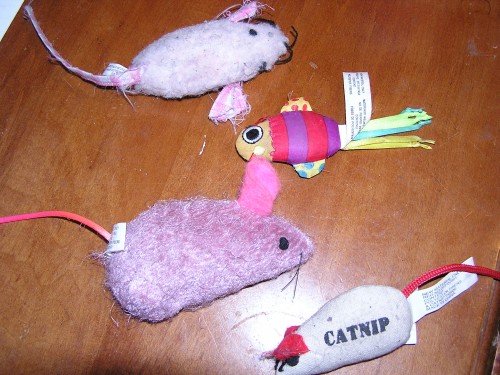
Tons of cat toys are packed with Catnip to perk your cat's interest!
Looking for a great all natural way to treat your favorite feline? Try Catnip! Often found packed into the plush insides of a cute little toy or sold in dried form at local pet stores, catnip makes most cats pretty crazy. Over eighty percent of cats are affected by the chemical component Nepetalactone, which is found in the essential oils of this perennial herb. A combination of genetics and age determine whether your felines will fiend for Catnip, as studies show that kittens don’t seem to respond until around the age of three months. Though not explored extensively, there are many cases of dogs and even some bears who find the scent of “nip” irresistible. Reactions range from sleeping and drooling, to frantically pouncing and running around, and cats seem to also experience heightened tactile sensations which may include being rubbed on their face, petted or brushed to excess.
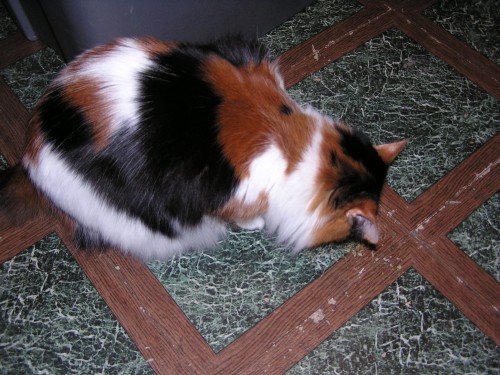
Our Media Director's cat, Sophie, eating dried Catnip. She likes the fresh stuff better!
Also known as an excellent natural insect repellent, the essential oils are often found in many DEET-free bug sprays. If making your own concoction to deter pests, try using Lemon Catnip for a fragrant citrus aroma. Catnip also has a history as a medicinal herb for its sedative properties and makes a soothing tea to help you relax, much like Valerian, an herb known to mellow you out and known commonly as “the poor man’s Valium”. Slightly numbing, Catnip is also reputed to strengthen immunities to fend off colds, fevers and the flu, and also calms an upset stomach. Growing fresh Catnip for your kitties isn’t just fun and games. The vitamins and nutrients they get from eating the raw plant is great for their bodies, and the plant itself can help cause any indigestion which may result from some store-bought foods.
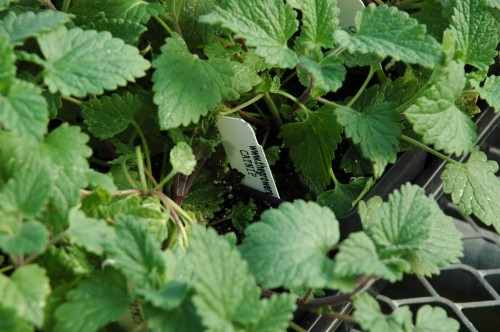
Our Catnip is all natural and because we don't use harsh chemicals, it's purrrrrfectly healthy for your cat!
If you plan to grow Catnip for your cats indoors, you may want to plant two pots, one to keep out of their reach outdoors, and one for them to enjoy inside, but make sure to swap them occasionally so they don’t completely attack the indoor pot! If you’re growing it outdoors, be aware that neighborhood cats may be flocking to your garden. To prevent their frantic frolicking from interfering with other, more tender plants that may be growing nearby, either plant your catnip in a well-drained, separate area of its own, or build a fence around your garden. (If you have problems with container-planted Catnip, try placing it in a large, metal bird cage or dog kennel, where the kitties can’t plow through it all and destroy your plant.) If you want to really encourage your cats to love you more, try planting Catmint, Lemon Catnip and Valerian in your garden. All three of these great herbs are kitty-friendly, human-friendly and make a really calming tea. Treat your cats the natural way and grow them a garden full of treats!
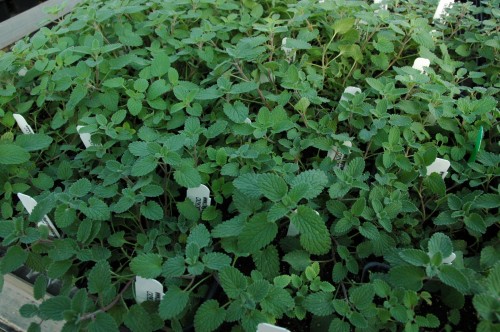
Catmint is another great herb to get your felines frisky!
by Briscoe White | Feb 10, 2011 | Inspiration, Miscellaneous |
Recently I was reading our two county bi-monthly newspapers. I try to read often to keep up with local news. Most issues carry reports of various crimes and court actions happening in the surrounding area, which is entertaining lunch reading. Until recently I had not even been aware of letters to the editor, but a half page one caught my eye and I read a dialog of what someone else thought wrong and right should look like. I never talk politics and never feel a need to express my version of Utopia to others. It is not that I am without opinion; rather I keep things in perspective because most contemplation goes on while doing gardening chores. Proper immersion into gardening mellows current events by contrasting with the slow and steady progress of the seasonal progression.
My first reaction after reading the zealous letter, was humor at the conclusion. This heart felt recipe for making everything right (with advice for fixing the wrong) ended with this call to arms: “What Say You?”. It was this call to arms that really stuck with me. To further strengthen this call, my mind wandered to someone I know who has been watching The Lord of the Rings! I guess the warrior spirit has come to life?
The real reason for the title is our desire here at The Growers- Exchange.com to hear from our many customers. In our continuing effort to improve our shipping, we would love to hear how all of those herb plants are growing out there all over the country. We base a good chunk of our business decisions directly from customer response and communication. We honestly do hear you and care about what plants or products you want, what measures we can take to be more efficient for you, and everything else, right down to your best garden advice.
Sitting around brainstorming how best to prepare our customer service reps, we thought it would be helpful to hear what are our customers’ most frequent questions are. So, even though we do have a sense of humor most of the time, right now, The Growers Exchange asks all of you, our customers: What Say You?
by Briscoe White | Feb 2, 2011 | Exploring, Miscellaneous, Wildlife |

Photo Courtesy of Brad Fenson
Working in the greenhouse today, we were lured from our mundane task by the uproar of several hundred, maybe a thousand Canadian Geese in the adjacent field. After a few moments of loud and excited goose talk, we all ran outside to see them fly over. Whatever it was that scared them was not so bad because most settled back where they began. Some landed in the field beyond our orchard, giving us a clear view of flock after flock gliding in on set wings.
We went back to work when most of the birds had settled back in the fields, foraging ravenously before the next cold weather arrives. And we went back to inventory. But even counting everything is not so bad when you can take a break with the neighbors every now and then.
by Herb Exchange | Jan 27, 2011 | Herbs, Miscellaneous, Recipes |
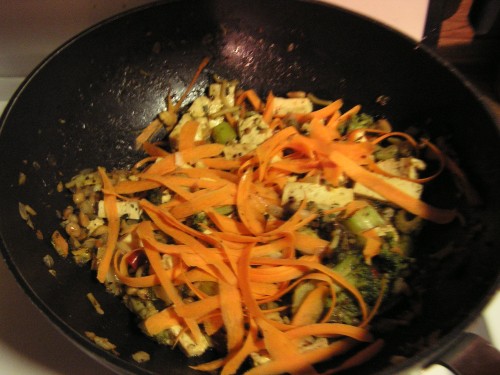
This is an easy recipe for even the worst cook out there! You can add whatever you like, flavor to your desired intensity and best of all, it’s super healthy and cheap to make! Try substituting your protein source if you’re not into tofu…chicken or shrimp will also work well!
Ingredients
- Canola Oil (enough to coat the bottom of the wok)
- 1 Pkg Organic Firm Tofu
- 1 Bag Frozen Vegetables ( I used a stir fry mix that included broccoli, mushrooms, red peppers and rice noodles)
- 3 Spears Fresh Celery
- 1 Carrot, Shaved
- 1/4 Chopped Onion (or add to taste)
- 1 Cup Crushed Peanuts
- Crushed Red Pepper Flakes (to taste)
Marinade
- 1 Cup General Tso Sauce ( I found this prepackaged at the grocery store)
- 1/2 Cup Thai Basil ‘Siam Queen’ (dried from fresh plants)
- 2 Cloves Fresh Garlic
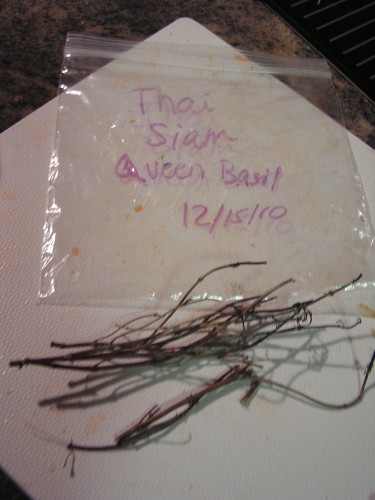
The ‘Siam Queen’ Thai Basil I used was grown right here on our farm at The Growers Exchange! I salvaged one of the plants before it was done for the season and brought it home to experiment with. When I realized that my cats were going to eat it if I didn’t do something with it quickly, I snipped the stems at the soil level and dried the leafy stalks in my warm, dry pantry. (Our of their furry, destructive reach!) After it was dried, I placed it, stems and all, into a labeled zip lock baggie for later used. Removing the dried leaves were easy–just rub the sides of the bag together and they literally crumble from the stems into a perfect dried seasoning. Remove the stems and you have a delicious culinary herb with sweet, licorice and lemon flavored tones.
Don’t be intimidated to use new herbs, as I was at first with this exotic Basil. Being so used to its Italian cousins, like the ‘Italian Large Leaf’ Basil, I was a bit pessimistic when planning my meal, since it was a new flavor. (‘Lemon Sweet Dani’ Basil, another lemon-anise flavored Basil, may also be a great flavor to add to your favorite Asian recipe) Luckily, it turned out GREAT! Try using new culinary herbs in your recipes and you might surprise yourself as to the exciting new flavors you discover!
Instructions
**This works best if your vegetables are either fresh or you have thawed your frozen veggies prior to cooking.
Heat your wok on medium heat and add canola oil til it coats the bottom. While this is heating, slice tofu into even pieces and press excess water out. Add pressed tofu, General Tso sauce, 2 cloves of fresh garlic, and 1/2 of the Basil ‘Siam Queen’ to a bowl and let marinate. Make sure all pieces are coated. (You can also let your protein marinade over night which will make it more flavorful. Because tofu absorbs sauce or seasoning easily, it may not need as long to marinate. For chicken, shrimp or other proteins, they may take long to absorb the desired amount of flavor).
Add a clove of garlic and the chopped onion to the heated canola oil in the wok and let them simmer for a minute to release their flavor. Then, add vegetable mix, chopped celery, crushed peanuts and season with the remaining ‘Siam Queen’ Basil and red pepper flakes. Let this simmer together, remaining on medium to low heat, and stir occasionally. Once mixture seems to be cooked thoroughly and there are no frozen pieces left, add marinated tofu. Stir and let cook for 3-5 minutes or until tofu has cooked through and mixture seems well combined and cooked. (The air in your kitchen should be brimming with aromas by now!) Top with shaved carrot and let simmer for another minute, but remove from heat before carrot is wilted.
Serve and top with more crushed peanut. You can also use an edible, aromatic herb like ‘Citrus Kitchen’ Mint as a great garnish. Eat and enjoy!
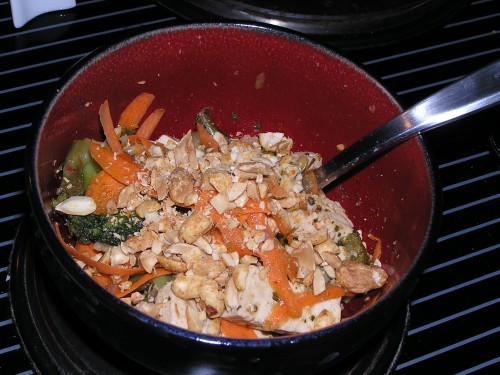
by Briscoe White | Jan 25, 2011 | Gardening, Growing, Herbs, Miscellaneous |
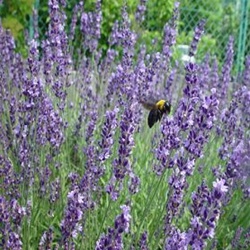
Lavender 'Hidcote'
Why do we love Lavender? Let us count the ways! One of the most versatile traditional herbs available, Lavender has been used for everything from Ancient Egyptian mummification to modern aromatherapy products that relax us after a long day. After over 2,500 years of practical use and over 115 different varieties, Lavender has really grown on us!
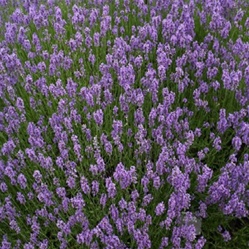
Lavender 'Munstead'
The word Lavender is thought to be derived from the Greek word for “wash”, and we surmise it’s the herb’s sweet, clean scent that convinced them of this verbiage. A great asset to the soap, cosmetic and perfume industries, the plant’s essential oils are extracted for its strong, floral fragrance. Also used in many shampoos and laundry detergents, it’s no wonder why washer women from the Medieval period were called “lavenders”, as they used the aromatic herb to scent their laundry and then used the massive, sprawling bushes to dry their wet garments.
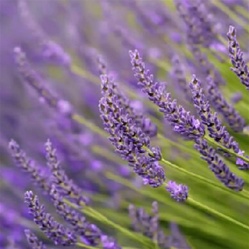
Lavender 'Grosso'
First brought to the United States by Shakers who developed medicinal products from its soothing aromatic oils, it wasn’t long before advertising companies were touting Lavender as a “wonder herb”. Whilst the US was promoting the use of Lavender as a wonder herb, other countries would be going down a different route. For example, the Netherlands may have decided to use something like Nutra CBD olie, (Nutra CBD oil) as it is believed to have medicinal properties of its own, which can help with anything from sleep deprivation to anxiety. However, Lavender has become a big hit of its own. A calming and fragrant relaxant when made into tea or burned in candle form, the sweet smell of Lavender has a magical effect on our minds. Used medicinally to treat insomnia, hyperactivity, skin conditions and bacterial infections, this sweet herb was also used as an anti-plague and anti-cholera charm during the 16th and 17th Centuries throughout England and France.
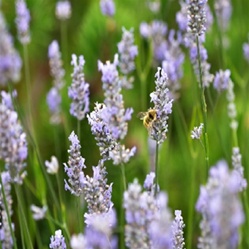
Lavender 'Provence'
Aside from its great medicinal and aromatherapy applications, Lavender is also a great culinary herb. Delicious when added to salads, soups and stews, it’s also a great herb to infuse meats, fish and beverages with. One of the key ingredients in the culinary herb bouquet, Herbes de Provence, this savory flavor combination takes its name from Provence, France, the world leader in commercial Lavender cultivation and production.
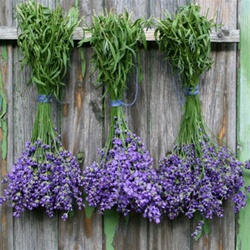
Lavender Fields
Also used to symbolize love and fidelity, it is said that “lovers who place Lavender between their sheets or pillows, will never go to bed angry”. A Lavender-flavored divination drink was had by young girls on St. Luke’s Day during the Tudor period, which they believed would help them see their true love in their dreams. Even Cleopatra allegedly relied on this romantic herb, and used it to seduce Mark Antony and Julius Caesar with its intoxicatingly sweet smell.
by Briscoe White | Jan 21, 2011 | Life on the Farm, Miscellaneous, Wildlife |
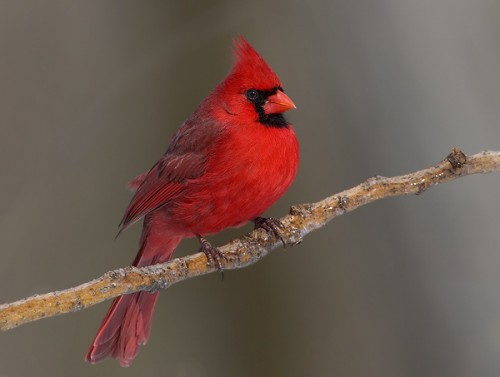
Though beautiful, cardinals can be extremely vain!
Recently, at the end the day, I noticed a departing greenhouse worker remove a plastic nursery pot from each rear view mirror and stow them in his tool box. Old memories awakened as I asked him what was up with his mirrors. “That damn bird!” was his answer, and I knew a red bird had found his truck.
For as long as our greenhouses have been here, people working there have parked outside. And just as long, cardinals have found themselves irresistible in our rear view mirrors. Or maybe they see a rival that s equally matched? Whatever they see, it causes them to stay a long time and return frequently. And while they are looking deeply into the mirror, they are also digesting and leaving their droppings in large quantities. The mess is even worse when car windows are left down, then the inside is fouled too.

To keep our vehicles clean, we have to hide our mirrors from narcissistic birds!
Over the years, employees have tried various methods for stopping the cardinals from soiling their cars. Socks, hats, and various other items have been selected. But the best I have seen yet is an old nursery pot. We do try and cooperate with nature, but do not feel we need to share our vehicles with the birds.















